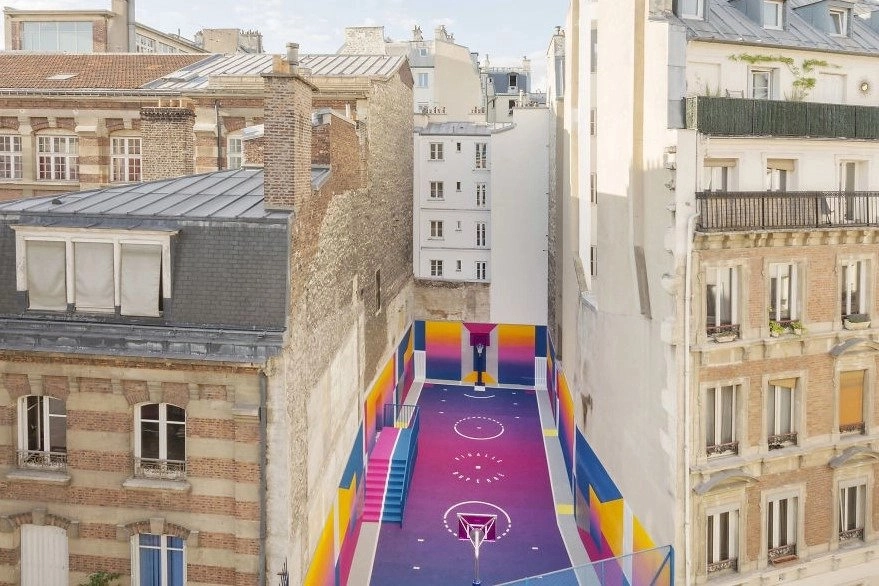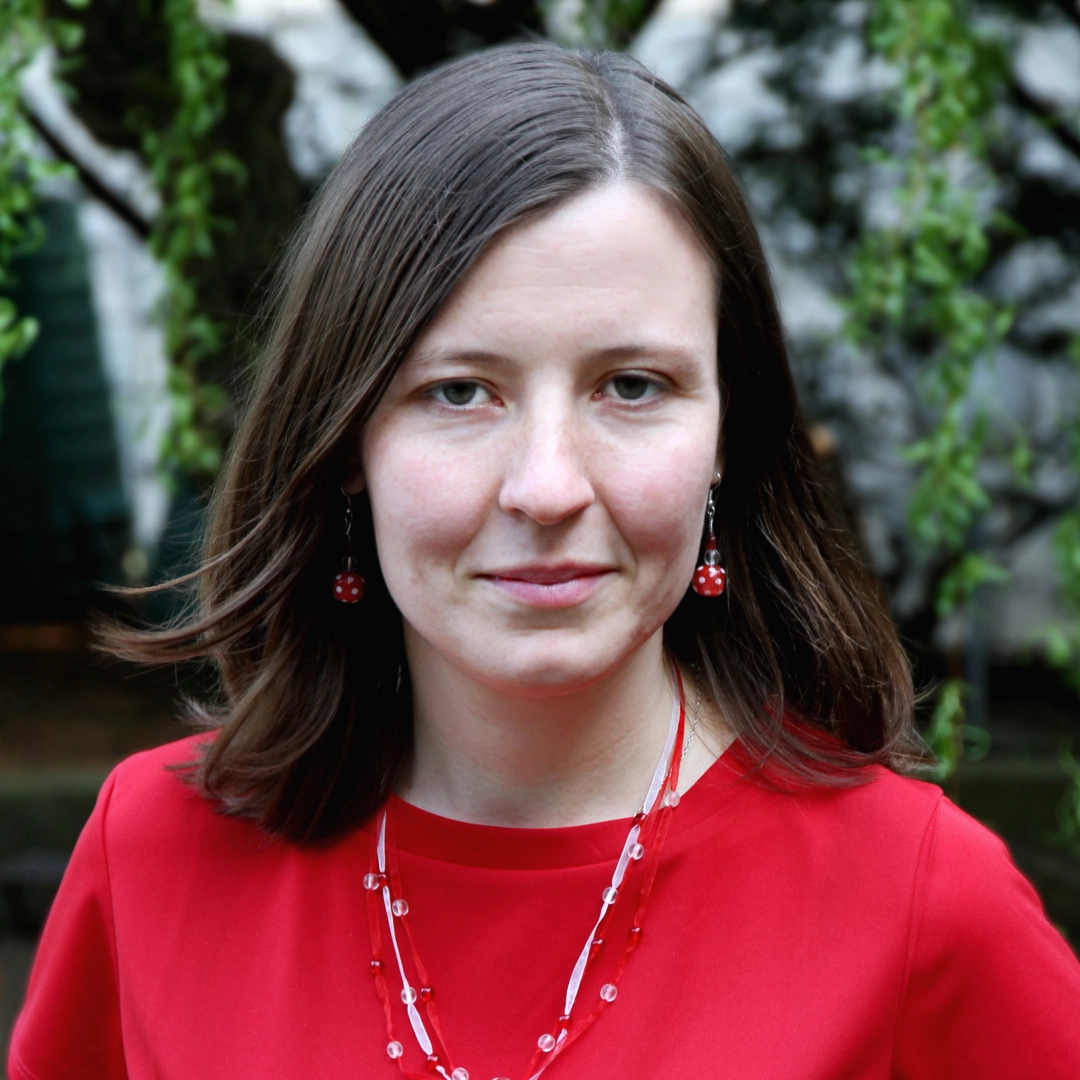Artistically rendered basketball courts bring colour to the usually drab concrete spaces all around the world. From American cities, the phenomenon has spread to the suburbs, parks and street corners of Europe, and even Prague has recently acquired its own visually striking court. For artists, playgrounds are becoming huge canvases that encourage the revival of public spaces in city centres and forgotten locations on their outskirts.

Basketball was born on the street, it is deeply tied to its culture and even the colourful basketball courts actually represent a particular form of street art. There are hundreds and thousands of public basketball courts worldwide in various states of disrepair, often in run-down plazas that are grey and neglected. Today, as in the past, public playgrounds help build community and bring people of different ages, statuses and backgrounds together. Compared to traditional basketball courts, spaces that underwent artistic intervention have a positive impact on the public's perception of these places and increase the diversity of their users, even those who would not think of visiting the court otherwise.
Decorated playgrounds empower the community, now even in Prague
Many initiatives around the world are trying to turn uninspiring or even problematic environments into colourful places that bring people together. But painting such a huge area is certainly not easy, since a typical playground is 28 metres by 15 metres. It takes many hours to decorate, litres of paint and often the wider surroundings need to be transformed as well.

The first friendly colourful basketball court has arrived in the Czech Republic, specifically at the Pražovka basketball court in Žižkov. It was thanks to the basketball player Tomáš Satoranský, who started on this Prague court and worked his way up to the NBA. Among his motivations, he also mentions the desire to expand the popularity of the sport through a more friendly environment. He jokingly called the court the Czech Rucker Park, after the famous court in Harlem, New York, where many later NBA stars got their start. He worked with the designers on picking the court’s surface.
The colourful labyrinth is a reference to the Italian futuristic painter
Basketball and colours have also made their way to Italy. In the town of Alessandria, the birthplace of futuristic artist Carlo Carrà, Sicilian artist GUE created a court decorated with coloured surfaces in orange, yellow, blue and grey. The asymmetrical pattern combining these bright colours is enhanced by the distinctive curves that create a harmonious abstract work. The court was created during the redevelopment of the city park and complies with all the rules of basketball.

Several basketball courts in northern Italy have been decorated by street artist Fabio Petani in collaboration with the StreetArtBall Project. He was trying to draw attention to the post-pandemic situation when the local community was slowly returning to the city after a period of confinement in their own apartments. The indoor plant Calathea Makoyana became a central motif, known for its ability to clean the air and absorb carbon dioxide particularly well. For Petani, the plant symbolizes the end of a challenging season and hope for a better tomorrow.

Street art artist AkaCorleone turned a playground in Lisbon, Portugal, into a huge surrealist painting. A closer look at the surface reveals an image of playing cards depicting a king and queen. In this work, titled Ballance, he explores the notion of duality, two different points of view, two different sides that complement each other and together form a whole.
A basketball court shines among the row of Parisian apartment buildings
The gap between buildings in the Pigalle district of Paris has already changed its appearance twice after being converted into a basketball court. In a collaboration between Ill-Studio and fashion brand Pigalle, the court’s surface and surrounding walls were first given a red, yellow, blue and white make-over inspired by the work of Russian artist Kazimir Malevich.

Later, the pitch was dressed in shades of pink, purple, yellow and orange. The new look, with geometric shapes and gradient colour transitions, was designed by French designer Stèphane Ashpool, who himself used to be an active basketball player and worked as a designer for brands such as Christian Dior, Rick Owens and Nike. The sportswear manufacturing brand was also involved in the court’s design.
A court in a Dutch flood dam and Belgian geometry
Rotterdam's Benthemplein Watersquare looks like a nice square with playgrounds and a skatepark, but it actually has another function. The individual dips in the surface can fill up with water and serve as flood protection. One of these basins houses a blue-hued basketball court, designed by the De Urbanisten company.

In neighbouring Belgium, local artist Katrien Vanderlinden was inspired by children's building blocks to decorate a basketball court in Alost. The multi-purpose court, called Ezelsplein, is decorated with geometric shapes in bright colours to inspire children to be creative and invent their own games.
Britain houses a number of decorated playgrounds
Britain's first artist-decorated court has been created in Brighton and is the brainchild of local multi-disciplinary artist Lois O'Hara. In collaboration with paint manufacturer Valspar, she has decorated the playing surface with abstract motifs in joyful colours, which have brought many basketball fans to Saunders Park.

The court in London's Bank Street Park has been transformed into a beautiful work of art by the British-Nigerian artist Yinka Ilori. Its surface is created using a 3D printing technique. One of the other courts that have been transformed by artists can be found in Walthamstow, East London. It too aims to provide young Londoners with a bright, lively place to play.

Birmingham-based graffiti artist Zuke collaborated with basketball player Kofi Josephs to transform the court at Summerfield Park in this UK city. The yellow and blue motifs are meant to symbolise the city of Birmingham, including a crown that stands for the local Jewellery Quarter.
The United States is not only the cradle of basketball but also of sports ground improvement projects
Given the popularity of basketball in the United States, it is unsurprising that we’d find the most artist-designed courts there. Many of them are the work of Project Backboard, a non-profit organisation that focuses on neglected sports fields on the outskirts of cities and in poor neighbourhoods. It's run by basketball enthusiast Daniel Peterson, who first started with small-scale playground repairs, but then moved on to larger-scale projects with an artistic twist.

One such venture, for example, was the redevelopment of a court in a St. Louis suburb. Artist William LaChance combines natural and pop culture inspirations in this huge colourful painting and uses different angles from which the viewer-player can observe his work. Indeed, many of the paintings created on playgrounds can only be seen in their entirety when viewed from the air; those who are directly on the field are more likely to perceive the effect of individual details and colours.
Project Backboard was also instrumental in redesigning the playground at Nicholas Park in upper Manhattan. Its new geometric form was created by American artist Faith Ringgold. She worked with triangular patterns and four basic colours, red, blue, yellow and green.

Another of New York's sports venues, specifically in Sarah D. Roosevelt Park, was designed by Brooklyn-based artist Brian Donnelly - Kaws, known, among other things, for his pop-art figurines. The artist created two illustrations, Elmo and Cookie-monster on a black background.
Victor Solomon handled the broken playing surface in Los Angeles in an interesting way, emphasizing its cracks in the same way the Japanese art of Kintsugi does with broken porcelain. Golden resin marbling runs through the court’s surface.

Another artistic court can be found in Colin Del Sol Park in San Diego, in Palmdale, California, where it was built with the aid of the local NBA basketball player Paul George. Yet another is in Montreal, Canada, where the court has been transformed into a work of art as part of the local MURAL Festival.
.jpg)





